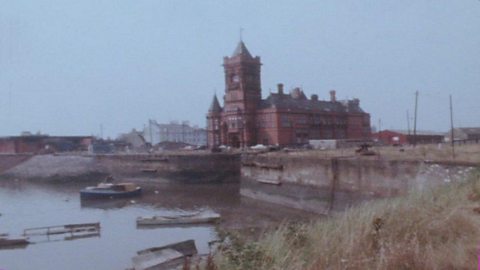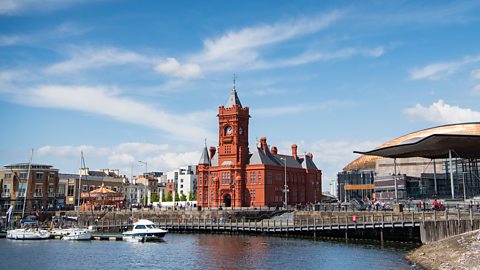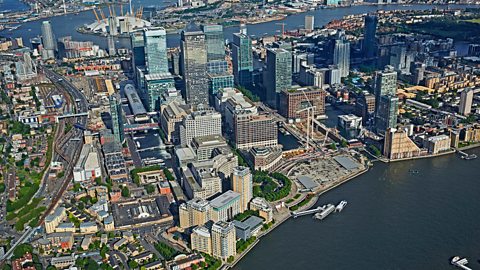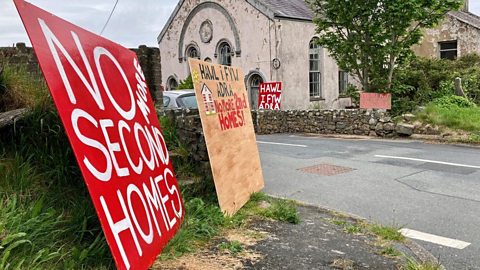What gives a place an identity?
A place's identity is formed by a complex and interconnected set of factors but a place does not need all of these factors to have an identity. The place can be any size - as small as a bedroom or as large as a city or even a country.
Physical
Places can be recognised and given an identity through their physical features. These can range from buildings and streets to mountains, forests and rivers. Many people will associate a place with a certain physical feature such as the coal mines in the valleys of south Wales or the mountainous landscape of the Eryri National Park.
Historical
Other factors that give a place its identity can relate to its history. This can have a role in how both local people and others might connect to a place because of its historic significance to them. That could be through the history of an industry that has played an important part in the local area or through battles that have been fought there.
Personal
We can also perceive an identity of a place on a much more personal level through our feelings, emotions and connections to it. People might see an area differently based on their experiences or connections they might have. This might be through language, culture or even sport.People will often have an affinity with a place due to a local sports team. Wrexham is a good example of this where the local football team plays a significant part in the lives of the people living there and is an important part of their identity.
The experiences we have of an area may also shape its identity. News reports about a place can portray the area in either a positive or a negative way to people who don’t live there.
Watch: Identity of place video
Watch this short clip to learn how a place can form an identity.
Whether we realise it or not, our home has a huge effect on our identity. In terms of culture, language… even sports. You could say that a place has its own identity. And, just like our own, that identity can change over time.
For much of the 19th and 20th centuries, Aberfan near Merthyr Tydfil was an unremarkable coal mining village – no different than any number of other industrial villages throughout the valleys of south Wales. But on the morning of 21 October, 1966, disaster struck. The colliery tip above the village collapsed, engulfing much of Aberfan – including Pantglas Junior School. 28 adults and 116 children died.
Aberfan was now much more than just an unremarkable coal mining village. As it came to the attention of Wales, the UK, and the world, it was plunged into the media spotlight. And while this media attention brought hundreds of people into the village in order to help in the aftermath of the disaster, it also changed the identity of Aberfan overnight.
Today, the children of Aberfan are brought up in the shadow of the disaster. Understandably, the identity of the village will be forever shaped by that terrible morning in 1966. Elsewhere in the world, terror attacks have had a similar effect.
In the immediate aftermath of the attack on the World Trade Center on 11 September 2001, New York City changed overnight. Political, cultural and religious differences were forgotten - temporarily - as the city came together to ’s a bitter irony that the darkest moments in our history can often bring out the best in people. But changes in the identity of place can occasionally cause us to react a little more violently.
Between 1979 and 1991, over 200 holiday homes in Wales were set ablaze. Various groups claimed responsibility, among them Meibion Glyndŵr - who were protesting against the rising house prices and language shift caused by incomers from England. To these people, the identity of their area was identical to their own. And they were willing to go a very long way to stop it changing.
The identity of a place can also be changed deliberately. In the 19th century, the rapid rise of industry in Wales led to the equally rapid development of Tiger Bay in Cardiff. During this time, workers from up to 45 countries made a new home in Cardiff, making it one of the most multicultural areas not only in Wales, but in the United Kingdom as a whole.
But as coal exports slowed, the fortunes of Tiger Bay declined. And so, at the end of the 20th century, it was transformed. Its old landscape cleared away, becoming the home of iconic buildings like the Millennium Centre, and the Senedd. Oh, and the name was changed – to Cardiff Bay.
Tiger Bay may be gone, but there are still people who remember it. Who have equally vivid memories of both Tiger Bay and Cardiff Bay. It goes to show the importance of keeping history alive. And that while places can change over time, we don’t always have to change with them.
Changing identities of place
A place’s identity can change substantially over time. Migration can bring in people from different backgrounds which can influence local culture and habits. Governments may choose to invest in an area. After redevelopment and programmes, an area that was once seen as old and derelict can be given a new lease of life as a modern and influential area filled with shops, apartments and green spaces.
Cardiff Bay
The area that we now know as Cardiff Bay once had a very different identity. It was originally known as Tiger Bay due to the fierce currents around the local tidal stretches of the River Severn. It was a very important location during the industrial age.
The docks in Cardiff exported coal from the south Wales valleys to the rest of the world. The building of the Glamorganshire Canal, which connected Merthyr Tydfil and Cardiff, made transporting iron and coal easier and led to the growth of the docks. The development of the docks brought sailors and dock workers from around the world to Cardiff. They settled in areas such as Butetown, contributing to the city's growth in population and giving the area its unique multicultural character.

Decline
The docks declined during the 1960s and 70s with increasing competition from other ports. By the 1980s large parts of the docks became derelict, paving the way for its redevelopment.


Redevelopment
In the 1990s the Cardiff Bay Development Corporation began redeveloping the area. A new barrage was built to create a new freshwater lake within the bay, completely changing the bay's appearance. Over the following years, there have been many new developments such as the St David’s Hotel, Techniquest, Mermaid Quay, Wales Millennium Centre and the Senedd.
These changes have completely reimagined the identity of the area - from an industrial area to an area that is now home to political decision making. The area also provides many social amenities, such as restaurants and an arts centre.
Like many other areas which have undergone redevelopment of their own, the transformation of the docks into Cardiff Bay was met with opposition by many local people. Reports claimed that the redevelopment had never included the local community of Butetown which argued that the change to the area would disrupt local communities and wildlife habitats. There is still an underlying divide between the Bay and Butetown to this day.

Canary Wharf
Another area in the UK that has undergone similar changes is Canary Wharf in London, on the site of the former West India Docks. Once one of the busiest docks in the world, they closed in 1980.
Decline
The decline of the docklands began during the Second World War when the docks were a primary target for air raids during the Blitz. The increasing use of container ships also contributed to the decline. These could transport larger amounts of goods but were too big to sail along the River Thames to reach the London Docklands.
Redevelopment
During the 1980s and 1990s, the London Docklands Development Corporation (LDDC) began to redevelop the area from a derelict site into one that could be used by the financial sector. New roads and railway links were built to connect the area with the rest of London and large skyscrapers were built to accommodate offices, shopping centres and restaurants.
Some local people who continue to live in the surrounding areas are unsure of the changes to Canary Wharf. Many believe the new jobs created there are for highly skilled workers who have a degree or come from elsewhere.
Many people believe that those working in Canary Wharf choose to live in wealthier parts of the city and commute to work. As a result, only a small amount of the money they make is invested back into the East End of London. This has contributed to a growing divide between existing boroughs and the newly developed Canary Wharf because of the very different identities they now have.

Loss of identity
Some areas of the UK are facing increasing issues with losing their sense of identity. One notable example of this is the county of Gwynedd.
9% of the houses in the county in 2021 were second homes. This figure was as high as around 23% in Beddgelert and 25% in Aberdaron.
Some people feel that it is increasingly difficult to maintain the area's local and national identity. In recent years there has been a growing demand for housing in these areas as people buy homes to be used as second homes or holiday homes. As the demand for housing increases so does the value of these properties. This often means that local people are unable to afford to buy a house in the area and have to move away.
As second homes may only be occupied for part of the year local shops and pubs may be forced to close as they aren't being used regularly throughout the year. These establishments are normally at the centre of communities and with their decline the spirit and traditions associated with them may be lost.
Protests
In recent years local people have held several protests to raise awareness of the problem and to call on the Welsh Government to take action.

In 2017 local authorities in Wales were given the right to charge up to double the standard rate of council tax on second homes.
In 2023 the Welsh Government gave local authorities extra powers so that they are able to:
- charge up to four times the standard rate of council tax on second homes
- change planning rules to make it harder for houses and flats to be bought as holiday homes
More on Identity
Find out more by working through a topic
- count1 of 3

- count2 of 3
